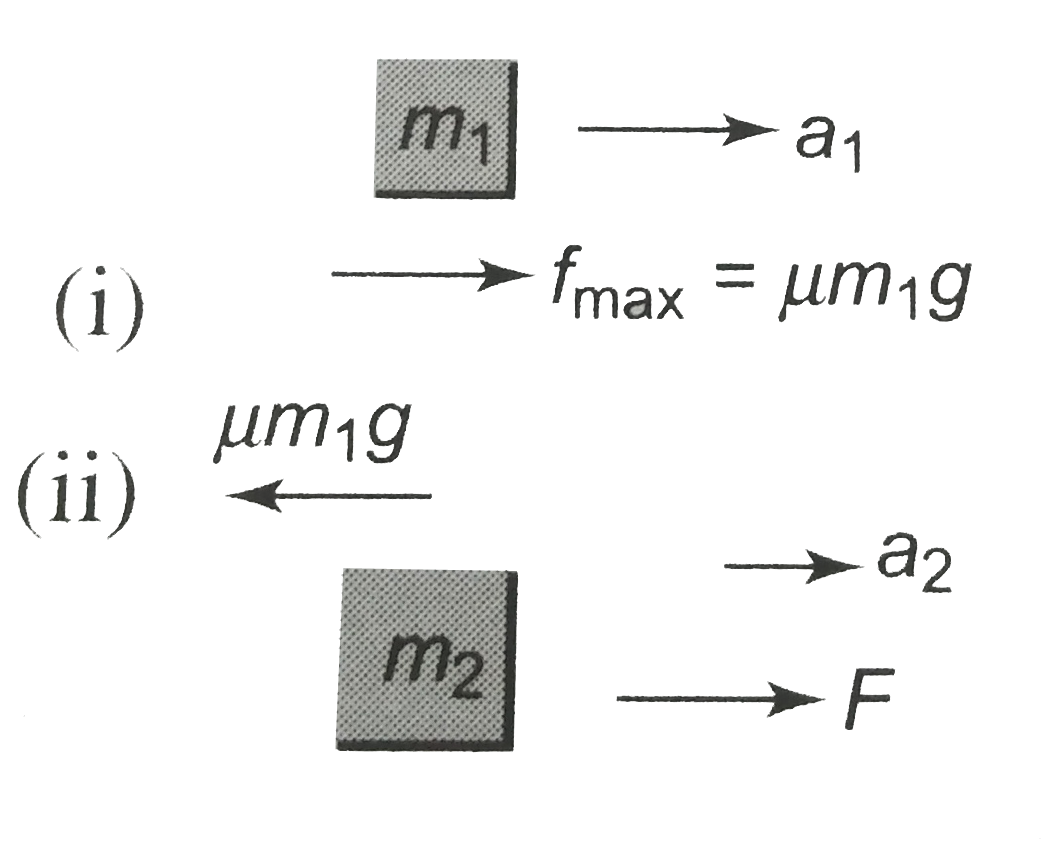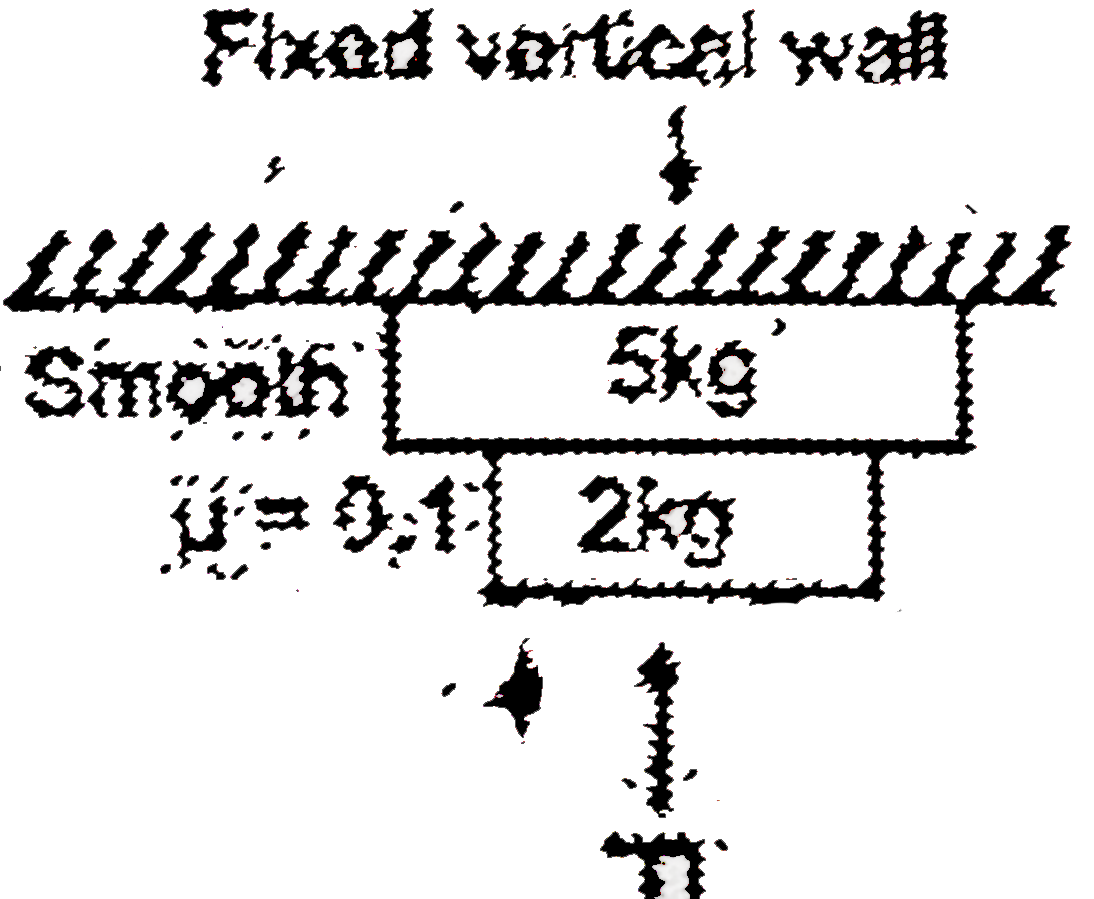The friction coefficient between the blocks is μ. If force F is applied on the lower block , analyse motion of two blocks.

When force F is applied on the lower block , two possibilities , either two blocks move together with same acceleration or the upper block will move in backward direction with respect to the lower block.
Let two blocks move together with acceleration a.
a=Fm1+m2
Since the upper block is moving in the forward direction , this is due to the friction force acting on it the forward direction.
When force F is applied on the lower block. the upper block has a tendency to move backward but the friction will try to prevent relative motion hence it will act on the upper block in the forward direction . But the friction has its maximum value μN=μm1g , up to a certain stage it will prevent the backward motion of the upper block with respect to the lowe block
f=m1a=m1Fm1+m2
fmax=μN=μm1g
Both the blocks will move together if
f≤fmax
m1Fm1+m2≤μm1g
F≤μ(m1+m2)g
The maximum value of F so that both the blocks move together
Fmax=μ(m1+m2)g
If F>Fmax , the upper block will move backward with respect to the lower block.
When F>Fmax ,
m1:μm1g=m1a1⇒a1=μg (i)
m2:F−μm1g=m2a2 (ii)
⇒a2=Fm2−μm1gm2
a1<a2 , acceleration of the upper block w.r.t. the lower block is in the backward direction.
After sometime the upper block will separate from the lower block.
To solve problems , assume that the blocks are moving together , find the common acceleration a=Fm1+m2.
(a) If a≤μg , the blocks move together.
(b) If a>μg , the upper block will move in the backward direction with respect to the lower block.
( c) The maximum value of F so that the blocks move together,
Fmax=μ(m1+m2)g


Topper's Solved these Questions
Similar Questions
A small block of mass 20kg rests on a bigger block of mass 30kg, which lies on a smooth horizontal plane. Initially the whole system is at rest. The coefficient of friction between the blocks is 0.5. The horizontal force F=50N is applied on the lower block.

a. Find the work done by fricitonal force on upper block and on the lower block in t=2s.
b. Is the magnitude of work done by the frictional force on upper and lower blocks same?
c. Is the work done by the frictional force on the upper block converted to heat or mechanical energy or both?
View SolutionOn a smooth horizontal surface a block A of mass 10kg is kept. On this block a second block B of mass 5kg is kept. The coefficient of friction between the two blocks is 0.4 .A horizontal force of 30N is applied on the lower block as shown. The force of friction between the blocks is
View Solution
Knowledge Check
In the arrangement shown in figure the wall is smooth and friction coefficient between the blocks is μ=0.1. A horizontal force F=1000N is applied on the 2kg block. The wrong statement is :
 AThe normal interaction force between the blocks is 1000N.BThe friction force between the blocks is zero.CBoth the blocks accelerate downward with acceleration gm/s2DBoth the blocks remain at rest
AThe normal interaction force between the blocks is 1000N.BThe friction force between the blocks is zero.CBoth the blocks accelerate downward with acceleration gm/s2DBoth the blocks remain at restA block of mass m=4kg is placed oner a rough inclined plane as shown in figure. The coefficient of friction between the block and the plane is μ=0.5 . A force F=10N is applied on the block at an angle of 30∘ .
 Astatic in nature in the direction up the plane and have the value 30.2NBstatic in nature in the direction down the plane and have the value 30.2NCkinetic in nature in the direction up the plane and have the value 30.2NDNone of these
Astatic in nature in the direction up the plane and have the value 30.2NBstatic in nature in the direction down the plane and have the value 30.2NCkinetic in nature in the direction up the plane and have the value 30.2NDNone of theseA block of mass m = 4 kg is placed over a rough inclined plane as shown in figure. The coefficient of friction between the block and the plane is u=0.5. A force F= 10 N is applied on the block at an angle of 30°. The friction force between the block and wedge is
 Astatic in nature in the direction up the plane and have the value 30.2 NBstatic in nature in the direction down the plane and have the value 30.2 NCkinetic in nature in the direction up the plane and have the value 13.5 NDNone of these
Astatic in nature in the direction up the plane and have the value 30.2 NBstatic in nature in the direction down the plane and have the value 30.2 NCkinetic in nature in the direction up the plane and have the value 13.5 NDNone of these
A block of mass m=4kg is placed over a rough inclined plane as shown in fig . The coefficient of friction between the block and the plane μ=0.5 A force F=10N is applied on the block at an angle of 30∘. Find the contact force between the block and the plane.
k

View SolutionTwo blocks of masses 'm' and and 'M' are arranged as shown in the The coefficient of friction between the two blocks is 'μ', where as between the lower block and the horizontal surface is zero. Find the force 'F' to be applied on the upper block for the system to be under equilibrium ? .

View SolutionA block of mass 5 kg is pulled along a horizontal. The friction coefficient between the block and the surface is 0.5. If the block travels at constant velocity, find the work done by this applied force during a displacement 4 m of the block.
View SolutionTwo block , with masses m1 and m2 are staked as shown in fig and placed on a frictionless horizontal surface . There is a friction between the two block .An external force of magnitude F is applied to the top block at an angle α below the horizontal . The coefficient of friction between m1 and m2 are μs
b. If the two blocks move together, find their acceleration
b . Calculate the maximum value of force so that blocks will move together

View SolutionOn a table three blocks (including the first block) are placed as shown in the figure. Mass of each block is m and coefficient of friction for each block is μ. A force F is applied on the block so as to move the system. The minimum value of F should be

View Solution
